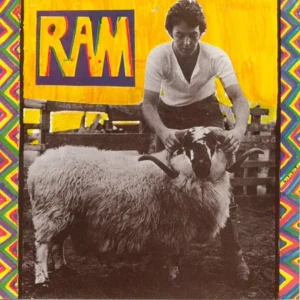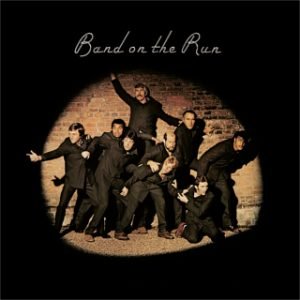Band on the Run stands as a defining moment in Paul McCartney’s post-Beatles career, marking his first major triumph outside the shadow of his former band. Released in 1973, the album not only solidified McCartney’s reputation as a solo artist but also propelled Wings, the band he formed with his wife Linda and guitarist Denny Laine, into the spotlight. After a series of mixed critical and commercial results with his early solo work and the initial Wings albums, Band on the Run proved to be the breakthrough he needed, showcasing McCartney’s ability to craft timeless music in the post-Beatles era.
With its blend of rock, pop, and orchestral elements, Band on the Run highlighted McCartney’s versatility as a songwriter and producer. The title track, along with hits like “Jet” and “Helen Wheels,” became radio staples and demonstrated the band’s potential to deliver chart-topping hits. The album’s commercial success, topping charts worldwide, and its critical acclaim cemented Wings as a force in the 1970s music scene. Decades later, Band on the Run continues to influence musicians and remains a cornerstone of McCartney’s legendary discography, embodying his creative resilience and ability to reinvent himself.
Background

In the wake of The Beatles’ breakup in 1970, Paul McCartney found himself navigating a new chapter in his career, facing the daunting task of establishing his identity as a solo artist. His first solo efforts, McCartney (1970) and Ram (1971), received a lukewarm response from critics, who were quick to compare his work to the Beatles’ legendary catalog. Seeking to reignite his creative spark and move past the constant comparisons, McCartney formed Wings in 1971 with his wife, Linda, on keyboards, guitarist Denny Laine, and drummer Denny Seiwell. The goal was to create a fresh, collaborative sound—distinct from the Beatles and rooted in a band dynamic.
However, the early years of Wings were far from smooth. The band’s first two albums, Wild Life (1971) and Red Rose Speedway (1973), were met with mixed reviews, with critics questioning McCartney’s artistic direction and the cohesion of the band. While some singles like “My Love” had commercial success, Wings struggled to find a clear identity, leading to internal tensions and lineup changes. Guitarist Henry McCullough and drummer Denny Seiwell left the band just before the recording of Band on the Run, leaving McCartney, Linda, and Laine to continue as a trio.
Despite these challenges, McCartney was determined to prove himself and Wings as serious contenders in the post-Beatles landscape. The desire for a major hit—and to silence the critics—became the driving force behind Band on the Run, with McCartney viewing the album as a crucial opportunity to rebuild momentum both personally and professionally.
Creative Vision and Inspiration

With Band on the Run, Paul McCartney set out to craft an album that would redefine his career and reestablish his creative prowess post-Beatles. After facing critical skepticism and personnel issues within Wings, McCartney approached the project with a clear artistic vision: to make an ambitious, cohesive record that reflected themes of freedom, escape, and reinvention—both personally and musically. At the heart of the album was McCartney’s desire to break free from the weight of expectation that came with being a former Beatle, while also expressing his frustrations with the industry’s demands and his own experiences with fame.
Thematic Concept
Thematically, Band on the Run is steeped in the idea of liberation. The title track tells the story of a band of fugitives on the run, a metaphor for McCartney’s own artistic journey, escaping the constraints of the past and finding new creative ground. This theme of freedom surfaces throughout the album, from the exhilarating energy of “Jet” to the serene beauty of “Bluebird.” Reinvention is another key motif, as McCartney used the album to rebuild both Wings’ identity and his own, pushing past the tumult of the band’s early years and asserting himself as an independent musical force.
Musically, Band on the Run is a masterclass in genre-blending. McCartney effortlessly weaves together elements of rock, pop, and orchestration, creating a rich sonic palette that ranges from the sweeping, multipart structure of the title track to the polished, radio-friendly sound of “Jet.” He also drew on his love of classical arrangements, adding lush strings and brass to tracks like “Let Me Roll It,” while incorporating elements of funk and blues to keep the sound dynamic and fresh. By combining rock’s raw energy with intricate pop melodies and orchestral depth, McCartney achieved a versatile, genre-defying sound that helped set the album apart from his previous work.
Recording Challenges
The recording of Band on the Run was fraught with unexpected difficulties, beginning with the sudden departure of two key members of Wings. Just before the sessions were set to begin, guitarist Henry McCullough and drummer Denny Seiwell quit the band, leaving Paul McCartney, his wife Linda, and guitarist Denny Laine to soldier on as a trio. This sudden shake-up forced McCartney to rethink the recording process and adapt to working with fewer musicians.
Despite these setbacks, McCartney pushed forward with his bold decision to record the album in Lagos, Nigeria. He had chosen the location in search of a more adventurous and exotic environment, hoping that the change of scenery would inject new energy into the music. However, the reality of recording in Lagos presented its own set of challenges.
The studio in Nigeria turned out to be poorly equipped, with substandard facilities and outdated equipment, which limited their ability to execute certain production techniques. To make matters worse, McCartney and his band experienced a harrowing mugging incident during which the master tapes and several personal belongings were stolen. Although the tapes were never recovered, McCartney refused to let the setback derail the project.
Health Concerns
On top of the technical difficulties, McCartney faced health concerns while in Nigeria. The hot and humid climate took a toll on the band, with McCartney himself suffering from severe bouts of bronchitis. These conditions forced the trio to work in intense, often uncomfortable circumstances, pushing their resilience to the limit.
Despite these obstacles, McCartney, Linda, and Laine adapted remarkably well to the situation. Without a full band, McCartney took on much of the instrumental workload, playing drums, bass, and most of the guitars himself. Linda contributed keyboards and harmonies, while Laine handled rhythm guitar and backing vocals. The reduced lineup led to a more streamlined, collaborative process, with McCartney’s multi-instrumental talents taking center stage. This minimalist approach resulted in a raw, focused sound that became one of the album’s defining qualities.
Key Tracks and Their Development
Several standout tracks from Band on the Run not only shaped the album’s success but also showcased Paul McCartney’s creative range and mastery of songwriting. Each track has its own distinct story and development process, highlighting McCartney’s ability to blend experimentation with pop sensibility.
“Band on the Run”
The title track is arguably the most ambitious and emblematic song on the album. Initially inspired by McCartney’s frustrations with the music industry and the desire for freedom, the song’s lyrics tell the tale of a group of people breaking free from imprisonment. Musically, it unfolds in three distinct sections, a multi-part structure reminiscent of McCartney’s work on Beatles songs like “A Day in the Life” and “You Never Give Me Your Money.”
The song begins with a slow, acoustic-driven introduction, conveying a sense of entrapment. As it progresses, the tempo shifts into a midsection featuring a funkier groove, driven by McCartney’s melodic bass line and layered harmonies, before exploding into an anthemic finale with soaring guitars and upbeat rhythm. This shift from introspection to liberation mirrors the theme of escape, making “Band on the Run” a dynamic and emotionally resonant centerpiece for the album. McCartney’s decision to structure the song in sections was a bold departure from traditional rock formats, showcasing his penchant for blending rock, pop, and orchestration into a cohesive narrative.
“Jet”
“Jet” is one of the album’s most energetic and infectious tracks, driven by a punchy, uptempo rock sound. The song’s origin remains somewhat cryptic—McCartney has given varying explanations over the years, from being inspired by a black Labrador dog to referencing his wife Linda’s horse. Regardless of its literal meaning, “Jet” represents youthful exuberance and rebellion, perfectly captured through its powerful guitar riffs, driving rhythm, and triumphant brass section.
McCartney’s use of a simple yet unforgettable chorus, paired with dynamic chord changes, gives the song its undeniable radio appeal. The track’s robust production, particularly the layering of horns and vocals, adds to its larger-than-life feel. “Jet” became one of the album’s breakout hits and remains a staple in McCartney’s live performances, emblematic of his ability to craft arena-ready rock anthems with intricate production techniques.
“Bluebird”
In contrast to the bombast of “Jet,” “Bluebird” offers a softer, more intimate side of McCartney’s songwriting. A gentle acoustic ballad, “Bluebird” evokes imagery of escape and freedom, in line with the overarching themes of the album. The song’s delicate arrangement, featuring fingerpicked acoustic guitar, smooth harmonies, and a subtle saxophone solo, creates a serene and reflective atmosphere.
Lyrically, “Bluebird” is simple yet poetic, with McCartney comparing the feeling of love to the flight of a bird, effortlessly free and unbound. The stripped-back production highlights McCartney’s knack for melody and his ability to convey deep emotion through minimalist arrangements. Linda McCartney’s harmonies and the restrained use of instrumentation allow the song to breathe, creating a calming contrast to the album’s more energetic moments.
Songwriting Techniques and Production Choices
Throughout Band on the Run, McCartney employed a range of songwriting techniques that allowed the album to feel cohesive while maintaining diversity in style and mood. The multi-part composition of the title track showcased his skill in constructing complex song structures that still resonated as accessible pop. His use of dynamic shifts in tempo and key helped convey narrative and emotional depth, while the simplicity of tracks like “Bluebird” demonstrated his understanding of when less is more.
In terms of production, McCartney embraced a DIY approach. With limited personnel, he played most of the instruments himself, crafting layered arrangements that balanced rock instrumentation with orchestral touches. The use of multi-tracked vocals, brass, and strings added richness to tracks like “Band on the Run” and “Jet,” while more intimate production choices on songs like “Bluebird” allowed for emotional subtlety. Despite the challenges of recording in Nigeria with limited equipment, McCartney’s inventive production techniques resulted in a polished yet raw sound that became the album’s signature.
Production and Sound

The production of Band on the Run stands as one of Paul McCartney’s most hands-on and resourceful efforts. With two members of Wings departing just before recording and only minimal studio resources available in Lagos, McCartney was forced to take on the bulk of the production responsibilities himself. This situation led to an intimate, DIY approach that emphasized McCartney’s multi-instrumental abilities and creative ingenuity, defining the album’s distinctive sound.
With limited personnel, McCartney played most of the instruments on the album, including bass, drums, guitars, and keyboards. This multi-tasking allowed him to maintain tight control over the arrangement and execution of each track. His meticulous layering of instrumentation is a hallmark of the album, giving it a rich, full sound despite the minimal personnel. McCartney’s bass work, in particular, is a standout, providing melodic counterpoints that anchor many of the songs, while his rhythmic guitar and piano lines created the foundation for the album’s sonic depth.
Layered vocal harmonies, another signature feature of Band on the Run, were central to the album’s production. McCartney and his wife, Linda, crafted intricate harmonies that gave tracks like “Band on the Run” and “Jet” a lush, expansive feel. These harmonies added warmth and depth to the album, making the sound feel more complete despite the absence of a larger band. Linda’s contributions, while often understated, were crucial to achieving the album’s polished vocal textures, particularly on softer tracks like “Bluebird.”
Studio Techniques
Innovative studio techniques also played a key role in shaping the sound of Band on the Run. Despite the challenges posed by the under-equipped studio in Lagos, McCartney found ways to maximize the available resources. He relied on overdubbing to layer instruments and used creative mic placements and room acoustics to enhance the natural sound of each instrument. For example, the brass sections in “Jet” and “Helen Wheels” were recorded to sound punchy and bold, contrasting with the softer acoustic guitar and vocals on “Bluebird.” McCartney’s experience as a producer allowed him to experiment with soundscapes, blending rock, pop, orchestration, and even hints of funk, as heard in the grooves of “Let Me Roll It.”
The final mix of Band on the Run showcases a clarity and depth that distinguished it from earlier Wings albums. Where previous records like Wild Life and Red Rose Speedway were sometimes criticized for lacking cohesion or focus, Band on the Run presents a tight, well-rounded sound. The production is cleaner and more refined, with greater attention to balancing instruments and vocals, ensuring that every track has its own identity while fitting into the broader narrative of the album.
Critical and Commercial Reception
Upon its release in December 1973, Band on the Run was met with widespread critical acclaim, a stark contrast to the mixed reception of Paul McCartney’s previous solo and Wings efforts. Critics praised the album for its ambitious songwriting, polished production, and cohesive sound. Reviewers highlighted McCartney’s ability to reinvent himself while maintaining the melodic brilliance and versatility he was known for during his time with The Beatles. Publications like Rolling Stone lauded Band on the Run as a triumph, noting its artistic depth and calling it McCartney’s most accomplished post-Beatles work. The album’s intricate arrangements, varied musical styles, and the title track’s multi-part structure earned particular praise, cementing McCartney’s reputation as a versatile and innovative songwriter.
Commercial Success
Commercially, Band on the Run was a major success, quickly rising to the top of the charts. It reached No. 1 on the Billboard 200 in the U.S. and remained in the Top 40 for over two years. The album also hit No. 1 in the UK, Australia, and several other countries, solidifying its global appeal.
The title track “Band on the Run” became a major hit, peaking at No. 1 on the U.S. charts and No. 3 in the UK. The album’s second single, “Jet,” was also a commercial success, reaching the Top 10 in both the U.S. and UK. Band on the Run eventually went triple platinum in the U.S. alone and became one of the best-selling albums of the 1970s.
The album’s success was further validated by numerous accolades, including a Grammy Award for Best Pop Vocal Performance by a Duo, Group or Chorus in 1975. Its commercial achievements helped Wings achieve legitimacy as a band and pushed McCartney into a new phase of his career, free from the shadow of his Beatles past.
In the long term, Band on the Run has only grown in stature. Today, it is widely regarded as one of McCartney’s finest works and a classic rock album. Its balance of musical experimentation and pop sensibility has influenced generations of artists, while tracks like “Band on the Run” and “Jet” remain staples of McCartney’s live performances. The album’s success not only solidified Wings as a major force in 1970s rock but also reestablished McCartney as a musical innovator capable of evolving his sound. Band on the Run continues to be celebrated for its artistic vision and enduring appeal, securing its place as a cornerstone in McCartney’s solo career and rock history.
